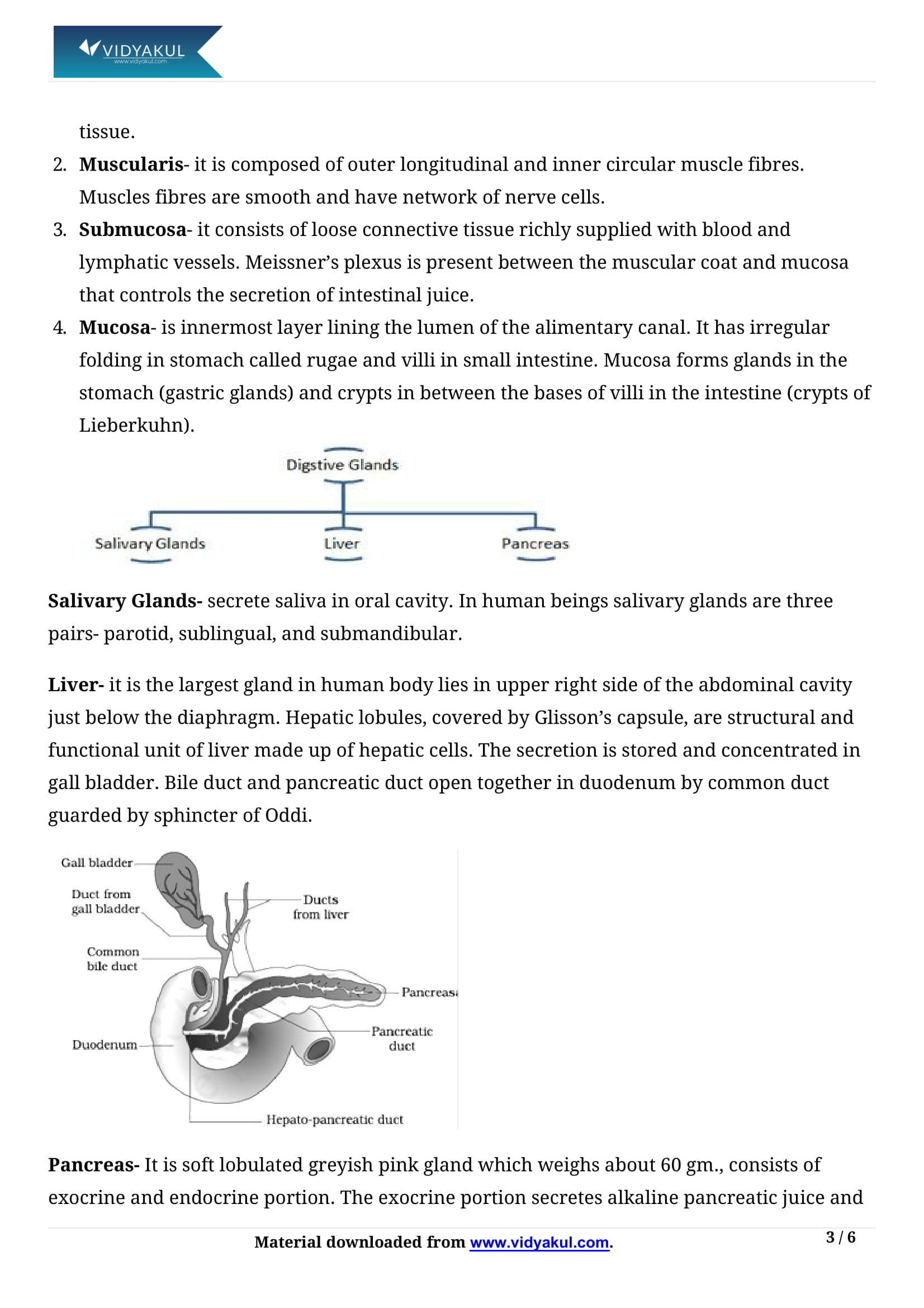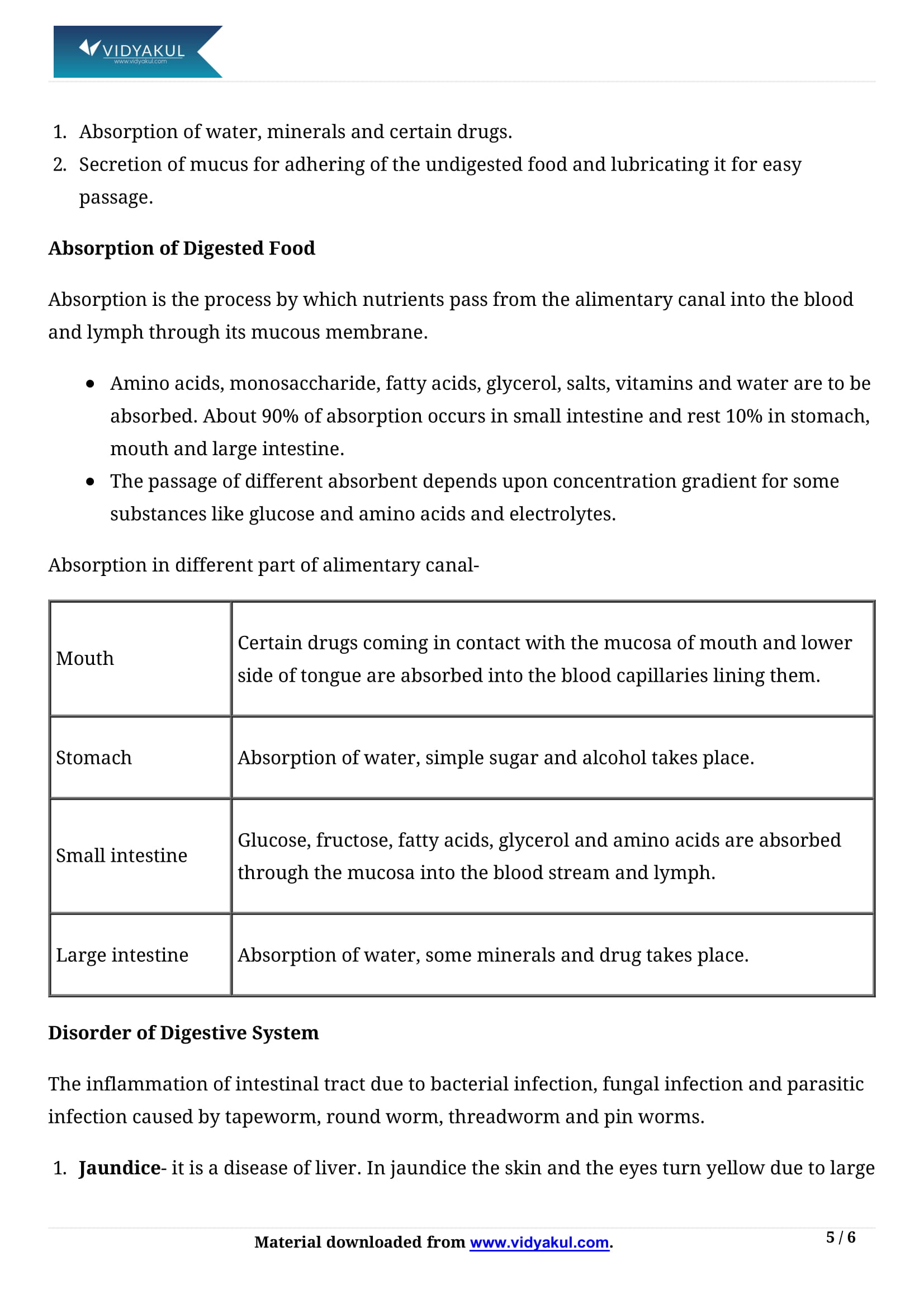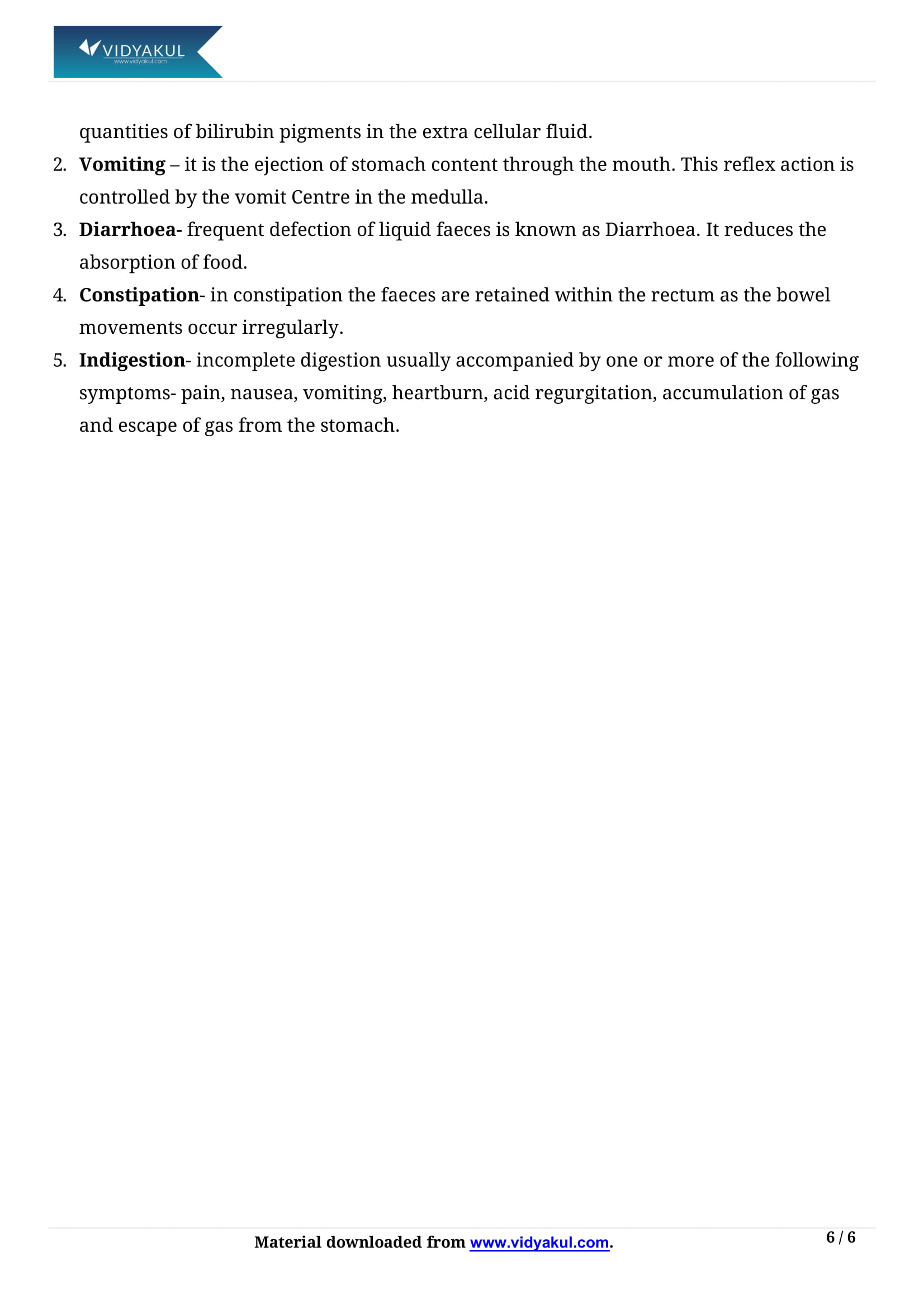Digestion and Absorption Class 11 Notes

Chapter 16 Digestion and Absorption
Digestion and absorption are important chapters in 11th grade biology. Knowledge of these topics will be useful for the annual exam and will help lay a solid foundation for NEET. You should practice these exercises to assess your readiness. Top faculty and scholars prepare NCERT notes for Class 11 Chapter 16 at Vidyakul.
Digestion and Absorption NCERT notes for Grade 11 are presented in a detailed and precise manner that is easy for students to follow. The notes also contain detailed chemical reactions to illustrate the concept. This will help students understand the subject matter. After all, performance will improve over time.
CBSE CLASS 11 BIOLOGY CH-16
Points to Remember
Alimentary canal begin with anterior opening mouth and opens out posteriorly through anus. It comprises of following parts:-
Mouth- leads to oral cavity or buccal cavity which contains teeth and tongue.
Upper surface of tongue has small projections called papillae, some of which contain taste buds.
Each teeth is embedded in socket of jaw bone (thecodont). Milk teeth is replaced by permanent or adult teeth, this type of dentition is called diphyodont. Four different types of teeth (Heterodont) are incisors (I), canine (C), premolar (PM) and molar (M).Dental formula: Each half of the upper and lower jaw has following number of teeth- 2123212321232123
Pharynx – oral cavity opens into pharynx which acts as common passage for food and air. Cartilaginous flap called epiglottis prevents the entry of food into wind pipe (glottis) during swallowing.
Stomach- Oesophagus leads to stomach. The opening of stomach is guarded by a sphincter (gastro-oesophageal). Stomach is divided into three parts- cardiac, fundic and pyloric.
Small intestine- is the longest part of alimentary canal divided into duodenum, jejunum and ileum. Pyloric sphincter is present between stomach and duodenum.
Large intestine- ileum opens into large intestine, which is divided into caecum, colon and rectum. Caecum is a blind sac which host microbes. Vermiform appendix arises from caecum. Rectum opens through anus.
Histology of Alimentary canal-
The wall of the alimentary canal from Oesophagus to rectum consists of four layers.
Serosa– it is the outermost layer made up of squamous epithelium and areolar connective tissue.
Muscularis– it is composed of outer longitudinal and inner circular muscle fibres. Muscles fibres are smooth and have network of nerve cells.
Submucosa– it consists of loose connective tissue richly supplied with blood and lymphatic vessels. Meissner’s plexus is present between the muscular coat and mucosa that controls the secretion of intestinal juice.
Mucosa– is innermost layer lining the lumen of the alimentary canal. It has irregular folding in stomach called rugae and villi in small intestine. Mucosa forms glands in the stomach (gastric glands) and crypts in between the bases of villi in the intestine (crypts of Lieberkuhn).
Salivary Glands- secrete saliva in oral cavity. In human beings salivary glands are three pairs- parotid, sublingual, and submandibular.
Liver- it is the largest gland in human body lies in upper right side of the abdominal cavity just below the diaphragm. Hepatic lobules, covered by Glisson’s capsule, are structural and functional unit of liver made up of hepatic cells. The secretion is stored and concentrated in gall bladder. Bile duct and pancreatic duct open together in duodenum by a common duct guarded by sphincter of Oddi.
Pancreas- It is soft lobulated greyish pink gland which weighs about 60 gm., consists of exocrine and endocrine portion. The exocrine portion secretes alkaline pancreatic juice and endocrine secretes hormones insulin and glucagon.
Digestion of food
Carbohydrates, fats, proteins and nucleic acids occur in food in the form of large and complex insoluble macromolecules (polymers). These macromolecules are converted into small monomers by the action of enzyme.
In buccal cavity, teeth and tongue help in mastication and mixing of food. Mucus in saliva mix with masticated food to form bolus.
Bolus is passed to pharynx and Oesophagus by swallowing or deglutition.
Chemical digestion of food starts in oral cavity by the action of enzyme salivary amylase and lysozyme.
Lysozyme acts as antibacterial agent in mouth to prevent infection.
Salivary amylase breaksdown starch into maltose
Mucosa of stomach have gastric glands having three types of cells- mucus neck cells that secrete mucus, peptic or chief cells that secretes proenzyme pepsinogen and pariental or oxyntic cells that secretes HCl.
Food mixes with gastric juice due to churning action of muscular wall to form chyme. HCl activates the pepsinogen to pepsin to digest protein into peptones and proteoses
Mucus and bicarbonates present in gastric juice play important role in lubrication and protecting inner wall of stomach from the action of HCl. Renin is a proteolytic enzyme found in gastric juice of infants to digest milk protein.
The Bile, pancreatic juice and intestinal juice are released in small intestine. Pancreatic juice contain inactive trypsinogen, chymotrypsinogen, procarboxypeptidases, amylases, lipases and nucleases.
Trypsinogen is activated by enzyme enterokinase in to trypsin, which further activates the other enzyme of intestinal juice.
Bile contains bile pigments (bilirubin and bil-verdin), bile salts, cholesterol and phospholipids which help in emulsification of fats.
Secretion of brush border cells of mucosa and goblet cells contain enzyme succus entericus, containing variety of enzymes to complete the process of digestion.
Function of large intestine
Absorption of water, minerals and certain drugs.
Secretion of mucus for adhering of the undigested food and lubricating it for easy passage.
Absorption of Digested Food
Absorption is the process by which nutrients pass from the alimentary canal into the blood and lymph through its mucous membrane.
Amino acids, monosaccharide, fatty acids, glycerol, salts, vitamins and water are to be absorbed. About 90% of absorption occurs in small intestine and rest 10% in stomach, mouth and large intestine.
The passage of different absorbent depends upon concentration gradient for some substances like glucose and amino acids and electrolytes.
Absorption in different part of alimentary canal-
Disorder of Digestive System
The inflammation of intestinal tract due to bacterial infection, fungal infection and parasitic infection caused by tapeworm, round worm, threadworm and pin worms.
Jaundice– it is a disease of liver. In jaundice the skin and the eyes turn yellow due to large quantities of bilirubin pigments in the extra cellular fluid.
Vomiting – it is the ejection of stomach content through the mouth. This reflex action is controlled by the vomit Centre in the medulla.
Diarrhoea- frequent defection of liquid faeces is known as Diarrhoea. It reduces the absorption of food.
Constipation– in constipation the faeces are retained within the rectum as the bowel movements occur irregularly.
Indigestion– incomplete digestion usually accompanied by one or more of the following symptoms- pain, nausea, vomiting, heartburn, acid regurgitation, accumulation of gas and escape of gas from the stomach.
Topics and Sub-topics
Before getting into the details of NCERT notes for Class 11 Biology Chapter 16, let us have a look at the constituent topics and sub-topics of this chapter.
Frequently Asked Questions
Write the changes occurring in the passage through the alimentary canal when a person has ingested roti and dal as part of his meal.
The following are the changes:
The teeth in the mouth masticate the food substances, wherein the carbs in the food are digested through the action of the enzyme secreted by the salivary gland – salivary amylase
The food at this stage is partially digested and reaches the stomach. Here it is treated with acidic HCl. The proteins in the food are digested through the proteolytic enzymes.
The gall bladder secrets the bile to digest the lipids present in the food
The semi-digested food is finally digested in the duodenum of the small intestine by the action of digestive enzymes in the pancreatic and intestinal juices.
The small intestine thus absorbs the disintegrated food in the form of glycerol, amino acids, starch, etc after digestion
The food that is not digested in finally eliminated from the system through the anus.
Write the mechanism of absorption.
It is the phenomenon through, which the end products of digestion pass via the intestinal mucosa into the lymph or blood, which is carried out through active, passive or facilitated transport means. Through simple diffusion, little quantities of monosaccharides such as amino acids, glucose and few electrolytes such as chloride ions are absorbed. The concentration gradients decide the passage of these substances into the blood. But amino acids and glucose are absorbed with the aid of carrier proteins and is referred to as facilitated transport. Water transport is dependant on the osmotic gradient. Active transport requires energy as it takes place against the concentration gradient. Through this mechanism, several monosaccharides such as glucose, nutrients such as amino acids, electrolytes such as Na+ are absorbed into the blood.
What is the significance of hepato-pancreatic complex in digesting protein, carbohydrate and fat components of food?
The pancreatic and bile duct secretes bile and pancreatic juices into the duodenum through the common duct – the hepato-pancreatic duct, which is shielded by a sphincter of Oddi. The pancreatic juice includes inactive enzymes –
Chymotrypsinogen
Trypsinogen
Procarboxypeptidases
Lipases
Amylases
Nucleases
The effect of hepato-pancreatic secretion on the digestion of fats, proteins, and carbohydrates are as follows:
Hydrolysis of carbohydrates in the chyme into disaccharides by pancreatic amylase
Fats are disintegrated into diglycerides and monoglycerides by lipases along with the aid of bile
Proteolytic enzymes of the pancreatic juice act upon the proteins in the chyme that reach the intestine to produce proteases.
How does digestion occur in the buccal cavity? Explain with the arrangement of teeth.
The buccal cavity has two important functions –
Masticates food
Facilitates swallowing
The tongue and the teeth with aid of saliva, masticate and blend the food completely. The mucus present in saliva helps in lubricating and holding the masticated food particles into a bolus. The bolus is further passed into the pharynx and down the oesophagus by deglutition or swallowing. The bolus moves through successive waves of contractions of the muscles down the oesophagus, this movement is known as peristalsis.
Define the following terms – Bolus, Mastication and Digestive Enzymes.
Bolus – It is round, ball-shaped and a mixture of a chewed food formed by the combination of food and saliva in the mouth or alimentary canal.
Mastication – It is the act of chewing the food. In this process, the food particles are broken down into smaller and soluble particles for ease of swallowing. This process occurs inside the oral cavity, including the teeth, tongue and the cheek.
Digestive Enzyme – They are the group of enzymes found in the digestive tracts and are secreted predominantly by the pancreas and other organs including the salivary gland, stomach and in the lining of the gastrointestinal tract. Digestive Enzymes play a key role in the process of chemical digestion.
Practice Questions
What is digestion, mechanical digestion and chemical digestion?
What are enzymes?
What is indigestion?
What is the process of digestion and absorption of carbohydrates?
Write the three major types of cells present in the gastric glands. List their secretions.
Write the organs of the human alimentary canal. Mention the major digestive glands along with their locations
Alimentary canal begin with anterior opening mouth and opens out posteriorly through anus. It comprises of following parts:-
Mouth- leads to oral cavity or buccal cavity which contains teeth and tongue.
Upper surface of tongue has small projections called papillae, some of which contain taste buds.
Each teeth is embedded in socket of jaw bone (thecodont). Milk teeth is replaced by permanent or adult teeth, this type of dentition is called diphyodont. Four different types of teeth (Heterodont) are incisors (I), canine (C), premolar (PM) and molar (M).Dental formula: Each half of the upper and lower jaw has following number of teeth- 2123212321232123
Pharynx – oral cavity opens into pharynx which acts as common passage for food and air. Cartilaginous flap called epiglottis prevents the entry of food into wind pipe (glottis) during swallowing.
Stomach- Oesophagus leads to stomach. The opening of stomach is guarded by a sphincter (gastro-oesophageal). Stomach is divided into three parts- cardiac, fundic and pyloric.
Small intestine- is the longest part of alimentary canal divided into duodenum, jejunum and ileum. Pyloric sphincter is present between stomach and duodenum.
Large intestine- ileum opens into large intestine, which is divided into caecum, colon and rectum. Caecum is a blind sac which host microbes. Vermiform appendix arises from caecum. Rectum opens through anus.
Serosa– it is the outermost layer made up of squamous epithelium and areolar connective tissue.
Muscularis– it is composed of outer longitudinal and inner circular muscle fibres. Muscles fibres are smooth and have network of nerve cells.
Submucosa– it consists of loose connective tissue richly supplied with blood and lymphatic vessels. Meissner’s plexus is present between the muscular coat and mucosa that controls the secretion of intestinal juice.
Mucosa– is innermost layer lining the lumen of the alimentary canal. It has irregular folding in stomach called rugae and villi in small intestine. Mucosa forms glands in the stomach (gastric glands) and crypts in between the bases of villi in the intestine (crypts of Lieberkuhn).
In buccal cavity, teeth and tongue help in mastication and mixing of food. Mucus in saliva mix with masticated food to form bolus.
Bolus is passed to pharynx and Oesophagus by swallowing or deglutition.
Chemical digestion of food starts in oral cavity by the action of enzyme salivary amylase and lysozyme.
Lysozyme acts as antibacterial agent in mouth to prevent infection.
Salivary amylase breaksdown starch into maltose
Mucosa of stomach have gastric glands having three types of cells- mucus neck cells that secrete mucus, peptic or chief cells that secretes proenzyme pepsinogen and pariental or oxyntic cells that secretes HCl.
Food mixes with gastric juice due to churning action of muscular wall to form chyme. HCl activates the pepsinogen to pepsin to digest protein into peptones and proteoses
Mucus and bicarbonates present in gastric juice play important role in lubrication and protecting inner wall of stomach from the action of HCl. Renin is a proteolytic enzyme found in gastric juice of infants to digest milk protein.
The Bile, pancreatic juice and intestinal juice are released in small intestine. Pancreatic juice contain inactive trypsinogen, chymotrypsinogen, procarboxypeptidases, amylases, lipases and nucleases.
Trypsinogen is activated by enzyme enterokinase in to trypsin, which further activates the other enzyme of intestinal juice.
Bile contains bile pigments (bilirubin and bil-verdin), bile salts, cholesterol and phospholipids which help in emulsification of fats.
Secretion of brush border cells of mucosa and goblet cells contain enzyme succus entericus, containing variety of enzymes to complete the process of digestion.
Absorption of water, minerals and certain drugs.
Secretion of mucus for adhering of the undigested food and lubricating it for easy passage.
Amino acids, monosaccharide, fatty acids, glycerol, salts, vitamins and water are to be absorbed. About 90% of absorption occurs in small intestine and rest 10% in stomach, mouth and large intestine.
The passage of different absorbent depends upon concentration gradient for some substances like glucose and amino acids and electrolytes.
Jaundice– it is a disease of liver. In jaundice the skin and the eyes turn yellow due to large quantities of bilirubin pigments in the extra cellular fluid.
Vomiting – it is the ejection of stomach content through the mouth. This reflex action is controlled by the vomit Centre in the medulla.
Diarrhoea- frequent defection of liquid faeces is known as Diarrhoea. It reduces the absorption of food.
Constipation– in constipation the faeces are retained within the rectum as the bowel movements occur irregularly.
Indigestion– incomplete digestion usually accompanied by one or more of the following symptoms- pain, nausea, vomiting, heartburn, acid regurgitation, accumulation of gas and escape of gas from the stomach.
Write the changes occurring in the passage through the alimentary canal when a person has ingested roti and dal as part of his meal.
The teeth in the mouth masticate the food substances, wherein the carbs in the food are digested through the action of the enzyme secreted by the salivary gland – salivary amylase
The food at this stage is partially digested and reaches the stomach. Here it is treated with acidic HCl. The proteins in the food are digested through the proteolytic enzymes.
The gall bladder secrets the bile to digest the lipids present in the food
The semi-digested food is finally digested in the duodenum of the small intestine by the action of digestive enzymes in the pancreatic and intestinal juices.
The small intestine thus absorbs the disintegrated food in the form of glycerol, amino acids, starch, etc after digestion
The food that is not digested in finally eliminated from the system through the anus.
Write the mechanism of absorption.
What is the significance of hepato-pancreatic complex in digesting protein, carbohydrate and fat components of food?
Chymotrypsinogen
Trypsinogen
Procarboxypeptidases
Lipases
Amylases
Nucleases
Hydrolysis of carbohydrates in the chyme into disaccharides by pancreatic amylase
Fats are disintegrated into diglycerides and monoglycerides by lipases along with the aid of bile
Proteolytic enzymes of the pancreatic juice act upon the proteins in the chyme that reach the intestine to produce proteases.
How does digestion occur in the buccal cavity? Explain with the arrangement of teeth.
Masticates food
Facilitates swallowing
Define the following terms – Bolus, Mastication and Digestive Enzymes.
What is digestion, mechanical digestion and chemical digestion?
What are enzymes?
What is indigestion?
What is the process of digestion and absorption of carbohydrates?
Write the three major types of cells present in the gastric glands. List their secretions.
Write the organs of the human alimentary canal. Mention the major digestive glands along with their locations
Learn more about it in Digestion and Absorption Class 11 Notes pdf.
Download this solution for FREE Download this PDF
Download Vidyakul App for more Important videos, PDF's and Free video lectures.









